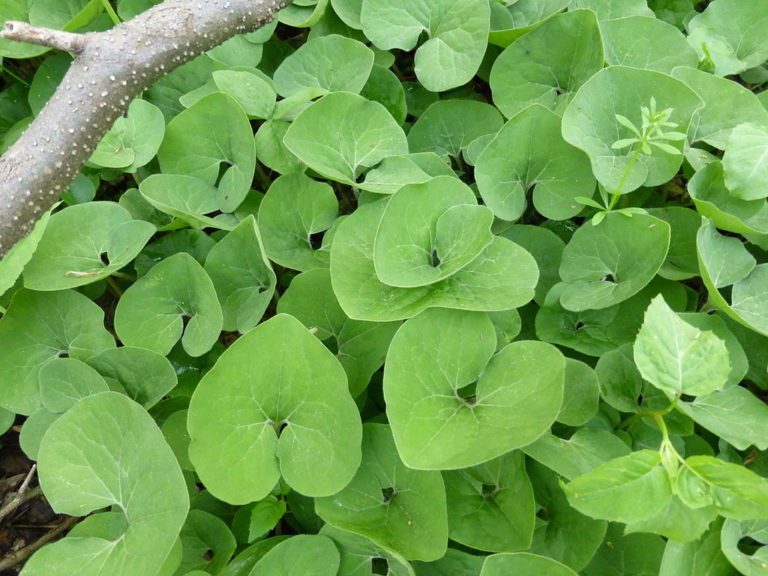Asarum, or Wild Ginger, is an herbaceous perennial which grows in colonies in shady woodland locations especially in the more northerly Eastern U.S. Each plant consists of two heart-shaped leaves emerging from a fleshy root/rhizome complex. Between these two leaves a single, somewhat inconspicuous maroon flower arises in May/June, most often hidden by the foliage. The flower is 3-parted, and missing petals, the sepals curve back emphasizing its triangular shape. It is believed Wild Ginger is self pollinated. The fruit is a dry capsule which opens in place. The seeds have an oily appendage called an elaiosome which attracts ants, which then disperse the seed across the forest floor. The leaves of Wild Ginger can reach 6 inches across and they persist throughout the growing season, forming an excellent ground cover. It prefers medium to moist, well drained, slightly acidic soil. It is reported to be deer resistant. As a member of the Pipevine family (Aristolochiaceae) it is a host for the Pipevine Swallowtail butterfly. It is often confused with Hexastylis, a superficially similar-looking member of an entirely different, but related, family, the Acanthaceae.
NURSERY HOURS
Wednesday: 10-4 Thursday: 10-6 Friday-Saturday: 10-4 Sunday: 12-4
Asarum canadense

Key Info
Scientific Name: Asarum canadense (L.)
Common Names: Wild Ginger, Heartleaf Ginger
Family Names: Aristolochiaceae (Birthwort Family)
Flower Color: Maroon
Additional Info
Habit: This groundcover has an unusual habit: each pair of leaves, supported by petioles arising directly from a fleshy root/rhizome complex (without stems), bears a single somewhat inconspicuous perfect flower. Colonies spread by means of these rhizomes but also by seeds distributed by ants.
Height: 6-8 inches
Spread: indeterminate
Soil Conditions: Medium to moist, well drained, slightly acid pH.
Leaves: Heart-shaped (cordate) with pronounced venation
Flowers (or reproductive structures: 3-parted flowers borne in the axil between the two leaves which make up this plant. The flowers lack petals but the sepals curve back, presenting a triangular form.
Fruit: "a small mealy pod that looks similar to the flowers", ripe in late spring. But it is recommended to propagate by division as seeds don't always germinate
Natural Distribution: Occurs in rich forests
USDA Hardiness Zone: 4-6
USDA Wetland Indicator Status in NC: FACU (Piedmont) and UPL (Coastal plain)
Pollination: While cross-pollination is possible, most seeds are the product of self-pollination.
Wildlife Connections: Ants are attracted by the oily elaiosome appendage on the seeds and disperse the seeds across the forest floor. Wild Ginger is a host for the Pipevine Swallowtail Butterfly. Reported to be deer resistant.
Propagation: Propagation by seed is described on the internet but division is a good way to do it.
